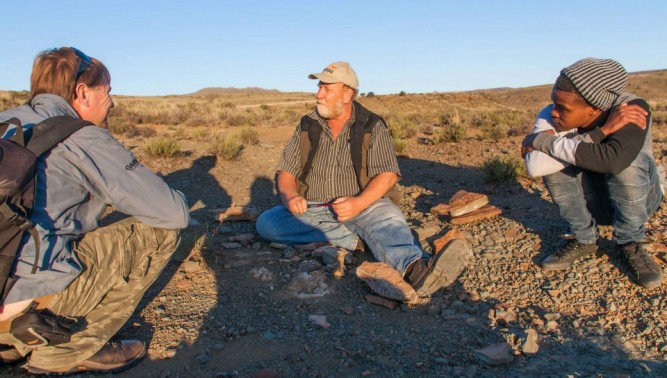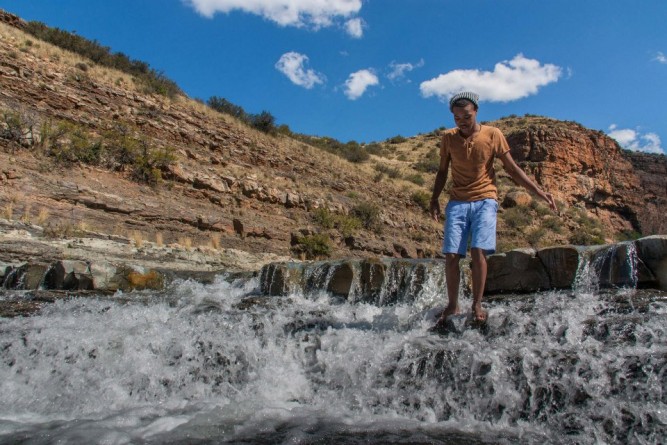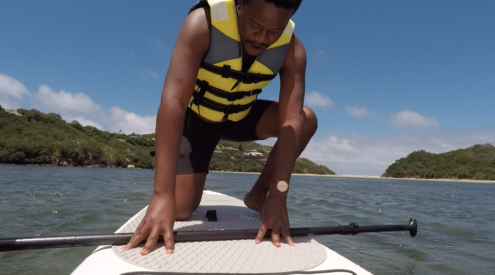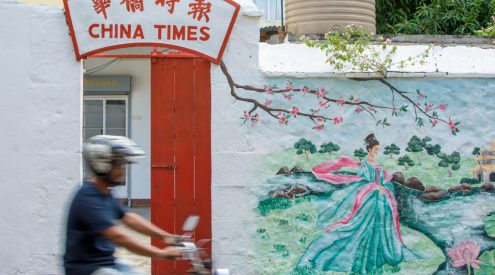After two days at the Karoo National Park, we hit the R61 towards Ganora Guest Farm and Excursions, near Nieu Bethesda. We knew nothing about the farm except that there were fossils within its premises.
On the R61, you get the feeling that you are in the heart of the Karoo. The gravel roads and the vegetation provide an other-worldly experience to the cityslicker. If you listen carefully you can hear the plants saying, “don’t frack up our Karoo.” Before we knew it, there was no cellphone signal. Thankfully, Bianca’s GPS came to our rescue and we found ourselves on Martin Street in Nieu Bethesda. The cellphone signal returned and, after a few calls, we were on the road again. We drove through Immelman Street and meandered the route to Cradock and Middleburg. 7 kilometres later, we reached Ganora Guest Farm.
Although Ganora is a three-star guest house, it is also a functioning farm with a rich history. Built in the 18th century, the farm survived the first Anglo-Boer War and plenty of floods through the years. Owners Hester and Jan Petrus Steynberg have retained the original buildings from the 1700s. The buildings have been transformed into guest rooms without losing their 18th century character. In front of the restaurant is a sheep stall. We settled into our rooms before JP (Jan Petrus) agreed to take us on a fossil tour.
We walked towards what we thought was one of the sheds on the farm. To our suprise, when JP opened the door, we were introduced to a mine of fossil discoveries. The miniscule farm museum has the mammal-like reptile fossils found in the Karoo. Inside the museum are fossils of almost every species that existed in the Karoo: from diconodon to tiny crocodile-like creatures. JP explained how the conditions in Karoo in different epochs allowed these creatures to survive. (You can read more in the article by Dale Morris, in the September edition of Getaway.)

Jan Petrus Steyne explains prehistoric-life at Ganora Guest Farm and Excursions. Photo by Bianca Preusker
After the tour of the museum, we headed off to the veld to see more fossils. I was amazed by how JP knew their exact locations. After a short tour, JP told us about how he became fascinated by fossils: it turns out the farmer was a good friend of world-famous paleantologist James Kitching. Kitching passed his knowledge about pre-historic life onto his friend. When the tour was finished, we returned to the farm.
Early in the morning, we put our luggage in the car and prepared to drive to the Water Tower in Nieu Bethesda. But before we did, we had to explore The Canyon between the farm and Nieu Bethesda. JP drove us to The Canyon while Hester took our vehicle to a nearby farm De Toren. Walking the Canyon isn’t child play. It’s a three-hour walk through sandstone cliffs and a well-developed river. In the beginning, we were all slicing our way through the bushes and dipping our feet in the water with smiles on our faces. As time went on, we ran out of walking space. We had two choices: walk through the water or wander about in search of a drier route. We chose the former. After trying so hard not to step on otter stools and meandering on steep slopes, we sat near the river and gazed at the Black Eagles flying above us. After three hours, we were on the other side of the canyon. Hester had parked our vehicle under a tree near De Torren.

The Canyon near Ganora Guest Farm. Image by Bianca Preusker
In the afternoon, Hester invited us to a guided tour of the farm. We visited the site where the former owner of Ganora Farm hid from the English during the first Anglo-Boer War. Apparently, he decided to leave a few bloody suicidal notes on the rocks at in the area. Hester deciphered the engravings and explained them to to us. We then headed towards the San rock paintings in the area, which was also a hiding place during the war.
The San rock art, located about 5 minutes away from from the guest farm, was discovered prior to the Anglo-Boer War. However, not much was said about them after the war. A century later, the Steyne family rediscovered the paintings. Since then, tourists from across the globe have visited the site. The site contains traditional aspects of San rock art in Southern Africa such San mythology, beliefs and celebrations.
What I learned
1. Some of the best stories are found off the beaten track. A small farm like Ganora Guest Farm, located in the back of beyond, has pre-historic life fossils that most paelantologists spent their lives looking for.
2. Get the full experience. Even though we were doing a story on fossils, we took time to engage in other activities on the farm. This allowed us to forge an idea of the farm and the adventure it offers.
Main image by Justin Fox.
Book accommodation at Ganora Guest Farm.
Related: The great fossil hunt: Karoo National Park

















